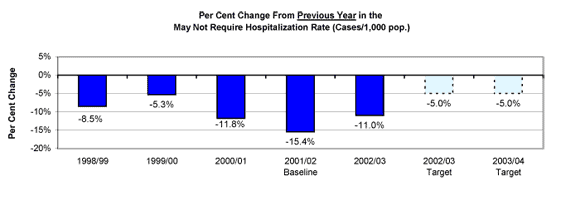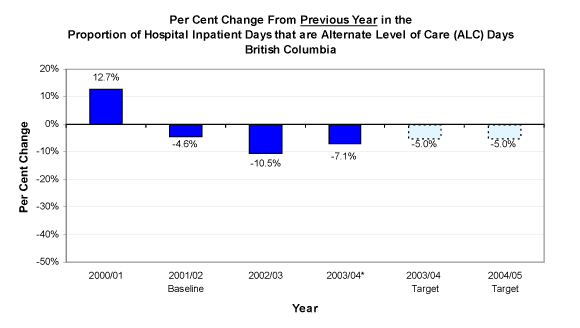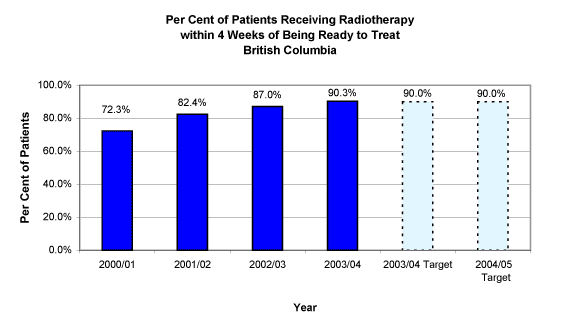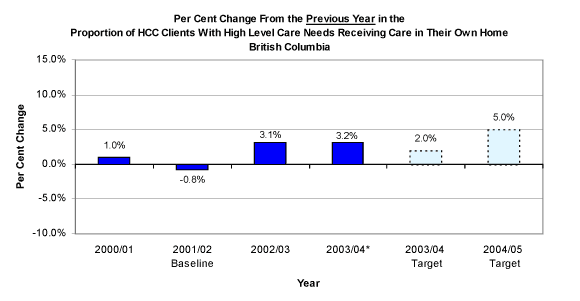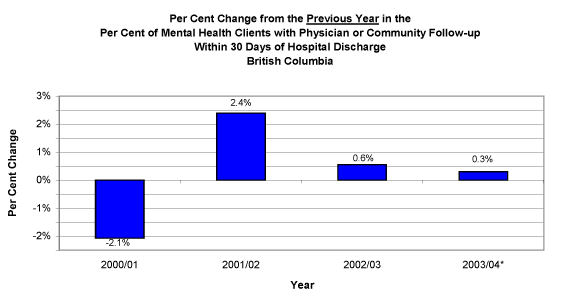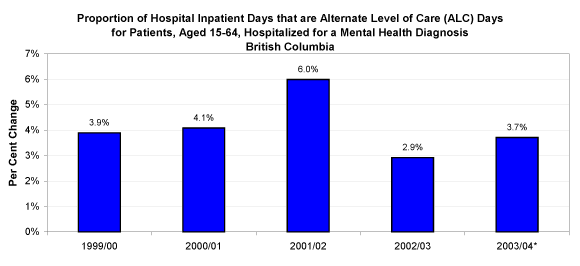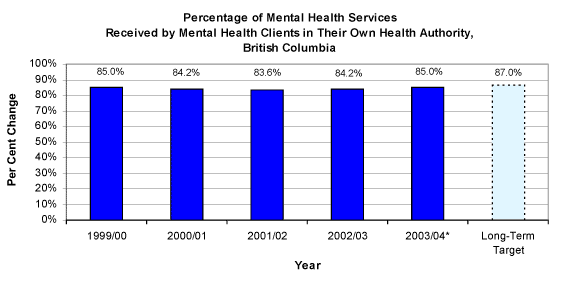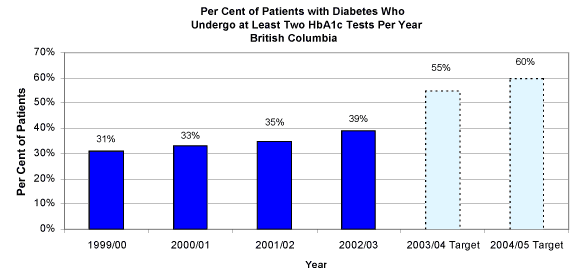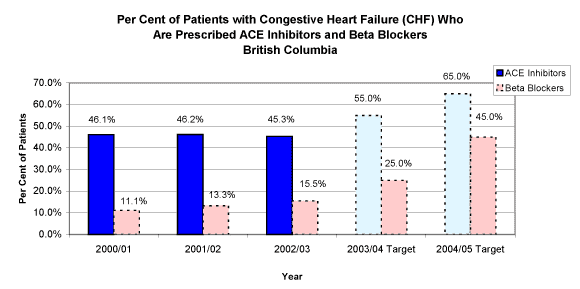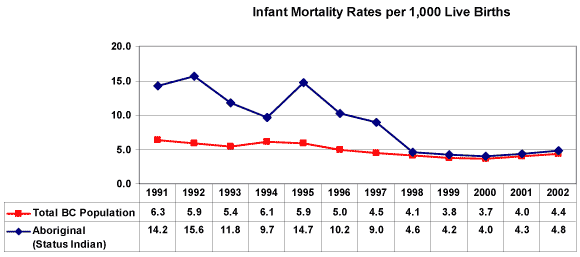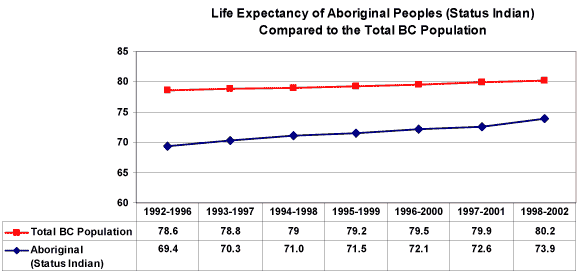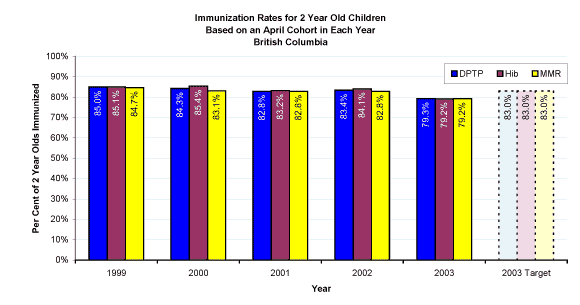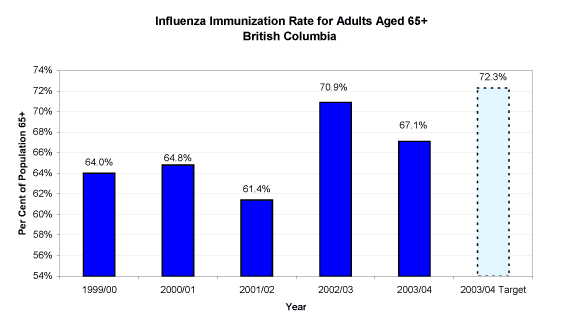 |
|
Performance Reporting Report on ResultsCore Business: Services Delivered by PartnersThe core business Services Delivered by Partners comprises the majority of health services delivered to the public. These services span beginning to end-of-life care, health promotion to disease prevention, and primary to acute care. There are four objectives under this core business, as outlined in the ministry's service plan. To achieve these objectives, the ministry works closely with those health care partners that deliver services directly to the public. Goal 1: High Quality Patient CareObjective 1: Provide care at the appropriate level in the appropriate setting by shifting the mix of acute and institutional care to more home and community care.Our hospitals, community services and health care professionals must be used in the most effective and efficient way possible to lead to the best patient outcomes. A problem at one level of the system has ramifications for others. For example, a lack of adequate services in the community could lead to the following gridlock in acute care: "Verna" is waiting in an acute care medical bed for appropriate services in the community to enable her discharge from hospital. "Fred" is on a stretcher in the emergency room waiting for Verna to move so a bed will become free to allow him to be admitted upstairs. "Ethel" is in the ambulance and diverted to another hospital because Fred and others are backlogged in the emergency room. "Jennifer's" elective surgery is delayed because of the shortage of acute care beds. This objective's aim is to avoid this scenario by bolstering services in the community. BC's health authorities are the ministry's key partners in changing the structure of the health system. Health authorities have been given the managerial scope to implement large-scale structural changes to how health care services are delivered. These redesign efforts, which were begun in 2001 and are still underway in communities throughout BC, are shifting the mix of services and health care providers to ensure care is delivered at the most appropriate level and setting. The goal is to create an integrated network of services, which links primary care, diagnostics, home and community care and acute care. In an integrated system the patient will move more easily between various settings and providers, and will not be left waiting at one level for services to be provided at another.
Many patients who are admitted for treatment to a hospital could receive appropriate care in a less intensive setting. The ministry, health authorities and care providers are working together to improve access to family physicians and other community resources so people can get the care they need, without unnecessary hospitalization. Enhancing primary care is the key to achieving this strategy. Primary care is a patient's first and most frequent point of contact with the health system and supports individuals and families to make the best decisions for their health. Patients access primary care when they visit their doctor, medical clinic, or public health unit. Between 2002 and 2006, BC has allocated $74 million from the Health Canada Primary Care Transition Fund to make improvements in primary care. Most of this funding has supported health authorities' initiatives in providing more comprehensive, accessible primary health care services. Regional initiatives include:
To provide 24-hour health resources to all British Columbians province-wide, the ministry continues to expand the BC HealthGuide Program, giving BC residents access to medically approved health information and advice 24 hours a day, seven days a week. This program consists of a 400-page BC HealthGuide Handbook, a companion First Nations Health Handbook, a comprehensive website at www.bchealthguide.org, the BC NurseLine and pharmacist services, and the BC HealthFiles. More information on the BC NurseLine can be found under Performance Measure 2.
This rate helps identify opportunities to more efficiently manage resources by focusing expensive, specialized hospital care on those who truly need it, and treating less acute cases in a more cost-effective and clinically appropriate manner. Specifically, when patients are admitted to hospital they are classified into case groups based on their diagnosis. One of these groups is "may not require hospitalization" (MNRH). Asthma and hernia are among the conditions that fall under this category — conditions which can be treated without admission to hospital. This performance measure helps the ministry assess success of the first part of priority strategy one, to "prevent unnecessary hospitalizations". Results:
Analysis: Data for 2003/04 is not available at this time. Data for 2002/03 is available and shown here. The data show a declining trend over several years in cases identified as "may not require hospitalization." This indicates improvements in providing appropriate care that meets patients' needs. Specifically, hospital services are being used for those patients who require acute or specialized care, while other patients who do not require hospitalization are receiving appropriate treatment in other settings. It is important to note that a target rate of zero MNRH cases is unrealistic. In some instances, a patient's clinical situation and/or other patient safety issues that may be taken into account by the admitting physician may well justify admission to hospital, even though the diagnostic coding indicates MNRH. Generally, a lower rate of MNRH is more likely to reflect efficient use of beds than a higher rate.
British Columbians can call the 24-hour BC NurseLine toll-free and speak with registered nurses specially trained to provide confidential health information and advice on the telephone. The nurses help callers understand and manage health concerns, get health information on home treatment and other care options, and get advice on when to see a health professional. BC NurseLine answers questions about various health topics, tests and medical procedures, and provides information on other community resources. BC NurseLine also provides a pharmacist service from 5pm to 9am daily to answer medication-related calls. Results:
Analysis: BC NurseLine has experienced significant growth in call volumes during its first three years of operation. Providing 24/7 access to health services is vital to improving primary health care and building a patient-centred health system in BC. The number of calls BC NurseLine receives helps gauge whether British Columbians are accessing health resources that will reduce demand on hospitals and physicians. Currently, it is general practice among physicians and walk-in clinics to direct patients to hospital emergency departments after hours. BC NurseLine provides an alternative for obtaining an assessment of symptoms or health concerns, and for getting the appropriate level of care. Since April 2001, when it began, there has been a dramatic increase in the number of callers referred by physician offices and walk-in clinics (part two of the measure). This indicates physicians and patients have been using the BC NurseLine option, thereby reducing demand on emergency and physician services. In 2003/04, including information on BC NurseLine in public health alerts such as SARS, forest fires and the flu campaign, contributed to the increase in call volumes. The ministry will continue to conduct outreach and educational efforts aimed at increasing awareness of the BC NurseLine by both the public and health professionals. Patients may remain in hospital longer than necessary for various reasons, including lack of available room in a residential facility or lack of community services to support discharge from hospital. The ministry and health authorities have been working to ensure the right mix of services is available so patients can access appropriate services once the need for hospital care has ended. This will result in better care for patients and better use of health system resources.
This measure indicates whether patients have timely access to appropriate care in the most appropriate setting. The days patients spend in hospital after the need for acute care has ended are called alternate level of care (ALC) days. A reduction in ALC days means more appropriate care is being delivered to patients, resulting in more acute care hospital beds being available for those who need acute care. Results:
Analysis: Based on preliminary data, the target for reducing the number of ALC days will be exceeded in 2003/04. The significant decrease in ALC days indicates more timely discharge of patients from hospital and the availability of more appropriate community health support. Health authorities have focused on better use of acute care hospital resources as a key priority and have implemented specific strategies to reduce ALC days. Over the last year, health authorities have added new sub-acute, hospice, and convalescent care beds to the continuum of care. Health authorities have also enhanced community supports, which include post-acute care provided by home care nurses, therapists and home support aides. As well, they have increased access to adult day care and assisted living — a relatively new care option that offers housing, hospitality and personal care services. In addition, more appropriate care and timely discharge from hospital have resulted from regional access lists for residential care and the creation of convalescent beds for patients who require a range of health services on a short-term basis before returning home.
While most of the strategies under this objective are focused on providing services outside the hospital, this strategy focuses on ensuring needed hospital services are provided in a timely and high quality manner. Under this strategy, the ministry and all six health authorities have participated in two province-wide projects to improve access to, and effectiveness of, emergency room and surgical services in hospitals across the province.
Monitoring wait times for these key services helps ensure patients' cancers are treated as early as possible to achieve the best outcomes. This indicator measures the percentage of patients that begin radiotherapy within four weeks of being ready to treat and the percentage of patients who start chemotherapy within two weeks of being ready to treat. Results:
Analysis: All radiotherapy treatments in BC are provided by the BC Cancer Agency (BCCA). The agency emphasizes the importance of timely access to radiotherapy. Over the past four years, the percentage of patients receiving radiotherapy within four weeks of being ready to treat has increased from 72.3 per cent in 2000/01 to 90.3 per cent in 2003/04. It is encouraging for both patients and the agency that the 90 per cent target has been reached for the first time in 2003/04. For chemotherapy, the BCCA has a standard in place that patients will receive therapy within 14 calendar days of the physician's order being written. The BCCA has confirmed to the ministry that patients in BCCA centres are being treated within the standard in 90 per cent of cases. (Historically, chemotherapy wait times have not been captured in the BCCA database; however, data to capture wait times for new patients is being implemented in early 2004.) Overall, British Columbia has excellent cancer outcomes, including some of the best survival rates in Canada for breast and prostate cancer, with 91 per cent of prostate patients and 85 per cent of breast cancer patients alive five years after diagnosis.
A set of guidelines, best practices and performance measures for the management of emergency rooms is being developed as part of the ongoing Provincial Emergency Services Project (PESP) that involves the ministry and each health authority. In 2003/04, the PESP released the Emergency Services Short-term Task Group Progress Report. All health authorities are now working to implement recommendations from this report. An Emergency Services Long-Term Task Group also began work in 2003 to create a strategic plan for long-term reform and improvement, and ongoing evaluation of the emergency services system. The Task Group has broad practitioner and health authority representation, including community, primary care and chronic disease experts. Provincial performance measures will be developed and adopted in future service plans and/or health authority performance agreements. Over the last three years, health authorities have been implementing redesign strategies to shift the balance of care from traditional residential care facilities to home and community options such as assisted living. This new model of care will better meet the needs of clients and their desire for more autonomy as they age. It will also help make the health system more sustainable by focusing resources on providing appropriate care in the appropriate setting, rather than simply admitting the elderly or disabled to facilities designed for complex care. In 2003/04, health authorities' redesign plans for Home and Community Care were well underway. The full implementation of a new access policy for residential care eliminated long wait lists by ensuring only those people who meet established criteria and require complex care are admitted to a residential care facility. To ensure more efficient use of residential care beds, health authorities have established priority access systems that coordinate the use of beds throughout each region, resulting in faster transitions from acute care to the appropriate care setting. With regard to community services, the commitment to build 3,500 new affordable assisted living units is underway with over 700 completed. This relatively new care setting offers an option for people who cannot live at home, but do not yet require the 24-hour nursing care and supervision provided in residential care. Another strategy is to provide more direct care services, such as home care nursing, occupational/physical therapy, and home support services for patients in their homes.
This indicator tracks the percentage of seniors and people with disabilities who have high care needs and receive home support or adult day care services to allow them to remain more independent. Evidence indicates more people can and want to remain at home for as long as possible if they have appropriate support. This improves quality of life and reduces demand for residential care beds. Results:
Analysis: Based on preliminary data, the target will be exceeded for 2003/04. This indicates more clients with high care needs are receiving appropriate home and community-based services, and avoiding institutionalization. Receiving support in their own homes improves quality of life for many clients and results in more efficient use of critical care resources. In 2003/04, health authorities focused on improving services and expanding care for patients with complex needs. Innovative home support services have been introduced, including cluster care — a more efficient, effective way of delivering support by assigning a home care aide to an apartment building to meet clients' needs throughout the day. Health authorities also expanded adult day care programs to monitor people at risk, keep them engaged in their community, and allow them to remain in their homes for as long as possible. Networks of Excellence for Geriatric Services, including community outreach, were also expanded. Specialized programs for Aboriginal clients and people with brain injuries were also developed to allow clients to remain in the community. Finally, health authorities implemented end-of-life care strategies, including appropriate supports to give people the choice to die in their homes, rather than an institution.
This strategy focuses on integrating and providing care in the most coordinated and seamless manner possible to the benefit of patients and health care providers. The first part of the strategy concerns adapting business processes and using technology to allow care providers, and facilities such as laboratories and hospitals to share information and provide coordinated care. Developing an electronic health record (EHR) system is essential for electronically linking health information to support clinical and management decision-making. British Columbia continues to make good progress in this regard and is seen nationally as one of the leaders in the development of the EHR. The second part of the strategy focuses on integrating and coordinating mental health and addiction services. In the past, people with mental illness or substance misuse disorders have generally not received the same level of care and respect as people with a physical illness. Mental illness and addictions are treatable, and with appropriate care and support, people can manage their illness better and achieve their full potential. The ministry is working with its health care partners to create networks of care in each health authority that better integrate mental health and addiction services — and coordinate other health services in the region. We are working to provide appropriate care in patients' communities, to minimize their time spent in institutions, and to improve their access to health professionals. In British Columbia, we are also building capacity for each health authority to deliver new mental health and addiction services. New facilities and services will create more home-like settings and expand the network of care throughout the province, eventually replacing Riverview Hospital. This approach will help improve health outcomes and quality of life for individuals with mental illness and/or addictions. This measures the percentage of persons aged 15-64 who have been hospitalized for a mental health illness and receive at least one follow-up treatment at a community-based Mental Health Centre or with a general practitioner or psychiatrist within 30 days of being discharged from hospital. This measure links to priority strategy 5b as a high rate of community or physician follow-up indicates well-coordinated, accessible continuity of care for people with a mental health diagnosis. Results:
Analysis: Over 70 per cent of mental health clients discharged from acute care hospitals receive timely follow-up by either a physician or a mental health centre. Since 2000/01, there has been a gradual increase in this follow-up rate, and based on partial year data the rate is projected to increase modestly in 2003/04. Health authorities are continuing to build networks of services to ensure mental health patients receive appropriate care. While increasing follow-up rates remains a priority, there are several factors why some patients may not receive follow-up within 30 days. For some patients there may not be a clinical need, while others may refuse follow-up treatment or fail to show up for scheduled appointments.
This measure indicates whether individuals with mental illness have access to timely, appropriate care in the most appropriate setting. Please note this measure is the same as the previous ALC measure (page 25), but focuses on people who are hospitalized for a mental health diagnosis. Reducing the number of days that patients spend in hospital after their need for acute care has ended indicates that appropriate services are available in the community. Results:
Analysis: Preliminary data suggest the target of further reductions in the ALC rate will not be met in 2003/04. Health authorities have been implementing strategies to improve discharge planning and utilization management, bolster community services, and strengthen networks of care. These strategies should keep the ALC rate low and help ensure mental health patients are treated in the most appropriate settings. This indicator measures the range of services mental health clients receive in their own communities or regional health authorities. This performance measure indicates our progress in improving access and availability of mental health care and community services for individuals in their regions. Results:
Analysis: Partial data for 2003/04 indicate we are making progress toward our long-term target of 87 per cent of clients receiving services in their own communities or regions. A project to decentralize specialized mental health services will further enhance the ability of health authorities to offer services in their own regions. In the past, seriously mentally ill patients have been treated at Riverview Hospital in the Lower Mainland. Now, as part of a redesign of mental health services, capacity is created in each region to treat those patients. The clinical teams at Riverview Hospital are working closely with those based in the geographic health authorities to improve access to specialized mental health services around the province. This will enable many Riverview Hospital patients to transfer to new, more home-like facilities closer to their home communities, and continue to receive the same high quality care and support.
Goal 1: High Quality Patient Care (continued)Objective 2: Provide tailored care for key segments of the population to better address their specific health care needs and improve their quality of life.The ministry is striving to build a health system that provides patient-centred services that respond to a continuum of needs over an individual's lifetime. Most people will need a range of services:
Clearly, one size does not fit all in health service delivery. For instance, the small number of patients who currently need and use health services the most are moving in and out of the health system constantly. These patients tend to have multiple chronic and/or terminal illnesses. Evidence shows our health system does not provide these patients with optimal seamless care and that improvements in care and outcomes can be made through innovation in our models of service delivery. The ministry is working with health authorities and physicians to design and deliver customized care that addresses the unique needs of specific patient sub-populations. To begin, the focus is on coordinating care for patients with extensive needs, proactively managing chronic diseases, providing better care for the dying, and addressing health inequalities in BC's Aboriginal population. Implementing a patient-centred approach for these populations can improve quality of life and health outcomes for patients and provide better use of health services.
A 2003 study shows a small percentage of BC's population uses a large percentage of medical services. For instance, the data analysis shows that in hospitals, five per cent of patients account for 54 per cent of bed days and 94 per cent of days spent in hospital after the need for hospital care has ended. This data has led the ministry to initiate a project to study the most frequent users of the system to find more effective ways of delivering their care. The ministry has been working with health authorities to better understand the common health concerns of this population and to develop evidence-based strategies to improve care. Research shows other jurisdictions have improved care and reduced costs by introducing specific strategies for high needs populations. For example, providing intensive targeted care in the community to the frail elderly, such as medical, rehabilitative, social and support services, improves their health and reduces the number of hospital admissions, ambulance calls and drug claims. Other examples with similar results include improved end-of-life care and accessible community services for individuals with mental illness.
A key component of the high needs project is to evaluate the impact of new initiatives. Evaluation and performance measurement will assist the ministry and its partners to improve services for high needs patients. As the project is still in its initial stages, specific performance measures have not yet been developed. As an interim performance measure the ministry will monitor the percentage of alternate level of care (ALC) days that high needs patients spend in hospital. For this patient group, ALC days are twice the average compared to the entire population. A reduction in ALC days will indicate more appropriate care options are available for this group. At the time of publication, 2003/04 data is not available for high needs ALC days. The following table, however, provides some historical data and shows recent trends. In the 2004/05 service plan, the ministry has targeted a five per cent decrease in the high needs ALC rate.
A chronic disease is an illness that cannot be cured completely. Diabetes, depression, congestive heart failure, hepatitis C and asthma are all chronic diseases. An estimated 500,000 British Columbians suffer from one or more chronic diseases. Effective management helps people with chronic diseases stay healthy and independent for as long as possible. The ministry and its partners have completed initiatives to ensure patients receive the highest standard of chronic disease management and care. Best practices and clinical guidelines have been developed for congestive heart failure, diabetes and other chronic diseases. In addition, in September 2003, the ministry launched a two-year project called the Full Service Family Practice Incentive Program. This program aligns physician payment with quality care and provides additional remuneration for services delivered according to guidelines, as well as compensating physicians for participating in quality improvement learning collaboratives. Finally, the ministry has created chronic disease patient registries to monitor the impact of improving care, and other web-based tools to support physician practice.
Diabetes is one of the most common chronic diseases, affecting about five per cent of Canadians; its prevalence is expected to increase significantly due to an aging population and rising rates of obesity. One component of effective diabetes care is to regularly monitor blood glucose levels. Blood glucose tests help flag potential complications for people with diabetes and allow care providers to help patients before their condition deteriorates. Results:
Analysis: From 1999/00 to 2002/03, the percentage of diabetes patients getting two HbA1c tests increased gradually from 33 per cent to 39 per cent. With the introduction of the BC Diabetes Care Guideline and the chronic disease management incentive payment in 2003, the ministry and its partners are tackling systemic barriers to accelerating the pace of change in diabetes care.
Over 37,000 British Columbians suffer from congestive heart failure — a chronic disease where the heart is unable to pump enough blood to meet the needs of the body's tissues. Research shows ACE inhibitor and beta blocker drugs, in combination with other treatments, significantly improve health outcomes for congestive heart failure patients; however, the rate of prescription for these drugs does not reflect the highest standard of care. In 2003/04, the ministry and its physician partners embarked on a broad-based collaborative to address and overcome challenges to increasing appropriate prescription rates of ACE inhibitors and beta blockers. Results:
Analysis: In the past, advances in care based on best-published evidence have diffused slowly. The Congestive Heart Failure Collaborative, which brings together the ministry and physicians, aims to change this. Starting in 2003 and concluding in May 2004, the collaborative has explored how to overcome systemic barriers to adopting best practices in care for congestive heart failure. From this work, the BC Congestive Heart Failure Guideline has been developed, along with a financial incentive program for treating patients according to the guideline. Performance is expected to improve slightly in 2003/04 and more rapidly thereafter. Annual figures cannot be calculated until after the Medical Services Plan year-end — the end of September following the fiscal year.
Palliative care is the specialized care of people who are dying; it is an integral part of a health system that meets the needs of people across their lifespan. Good palliative care is provided, where possible, in the setting of a person's choice and is delivered by coordinated teams of physicians, nurses and other health professionals such as pharmacists and nutritionists, and includes family input and volunteer services. The ministry is developing a Provincial Strategy for End-of-Life Care. In 2003/04, the ministry worked with partners, including health authorities, physicians and the BC Hospice Palliative Care Association, to enhance and coordinate palliative services across the province. In BC, publicly funded palliative care includes care provided in palliative care units or hospices in hospitals, as well as care provided in a person's home or other community-based setting. To promote innovative palliative care services, the ministry has introduced the Palliative Benefits Program, which provides medications, medical supplies and equipment to those who choose to die at home. Previously, those items were only covered if the patient stayed in the hospital. The Palliative Benefits Program is an important resource that allows health authorities and care providers to design programs to support people who choose to die at home or in settings outside the hospital.
In the 2003/04 service plan, the ministry stated its intention to develop a performance measure for palliative care. On an interim basis, the ministry will be monitoring and reporting the percentage of people accessing benefits under the Palliative Benefits Program. Although this measure only captures one component of palliative services, it does indicate broader access to palliative care based on the assumption that clients who access the benefits program are likely accessing other palliative services, such as physician, home nursing or hospice care. In the future, this indicator will be replaced with a more specific measure of access to palliative care. The development of a new measure is discussed in the analysis below. Results:
Analysis: Drug benefits under BC's Palliative Benefits Program have been available since 2001. The continued enhancement of palliative care, and especially community-based services, will likely lead to further increase in the use of these benefits. While measuring the percentage of people accessing palliative benefits gives an indication of the availability of palliative services, it does not monitor the appropriateness and effectiveness of service, or its quality. Currently, the health system cannot measure the performance of palliative services in that detail. However, under the banner of the Provincial Strategy for End-of-Life Care, the ministry's partners (health authorities and health professionals) will review and refine reporting mechanisms that identify the extent and scope of palliative care service delivery, and develop comprehensive indicators to monitor the benefit of providing palliative care services. Broader indicators will incorporate community-based services, such as direct care nursing and home support, hospices, enhanced services that support residents in their own care facility, general and specialist palliative physician services, and hospital bed days related to palliative care service delivery, as well as the percentage of clients accessing drug benefits. Until that work is completed, the ministry will continue to use the percentage of people accessing palliative care benefits as a proxy indicator for the availability and uptake of palliative care.
As a group, Aboriginal people have a level of health below that of the general population. To address this inequity, the ministry is working with Aboriginal health care partners and stakeholders to develop a Provincial Aboriginal Health Services Strategy. This provincial strategy will contribute toward improving Aboriginal health by providing strategic guidance and examples of best practices for Aboriginal organizations and health authorities. A provincial steering committee of key stakeholders and representatives are working together to develop this strategy. These include the First Nations Summit, Provincial Aboriginal Health Organizations, Community Health Associates of BC, Pacific Association of First Nations Women, and the BC Aboriginal Network on Disabilities. Each health authority has also worked with Aboriginal communities and organizations to develop an Aboriginal health plan to guide current service delivery in their regions. The ministry has also been working with the federal government and Aboriginal groups to develop a comprehensive Aboriginal health database to identify populations, incidence of chronic disease (such as diabetes) and access to standardized treatment resources. In early 2003, the BC First Nations Health Handbook, a new companion guide to the BC HealthGuide Handbook, was distributed. This handbook provides information on unique health services for First Nations, as well as advice for health professionals serving First Nations individuals and communities. By focusing on Aboriginal health issues and involving Aboriginal communities in the planning of health services, we can ensure the Aboriginal population has access to the services and information needed to improve its overall health status.
The Ministry of Health Services tracks infant mortality rates and life expectancy because they serve as useful indicators of the overall health status of Aboriginal people. Data for 2003 is not available; however, data for the past decade is presented and provides useful insight for trends in Aboriginal health status. Results:
Analysis: Infant Mortality Rate: Since 1990 in BC, the infant mortality rate for the Aboriginal Status Indian population declined from a high of 15.6 per 1,000 live births in 1992 to a low of 4.0 in 2000. Over the past decade, the gap between infant mortality rates in the Aboriginal population and the total BC population has decreased to being statistically insignificant. This is a vast improvement over the mid-1990's when the Aboriginal rate was over double the provincial rate. Specifically, there are two components to the infant mortality rate, neonatal (< 28 days) and post-neonatal (28-364 days). The Status Indian neonatal rate is lower (but not statistically significant) than for other BC residents, while the Status Indian post-neonatal rate is higher (this is statistically significant). The Status Indian overall infant mortality, while not significantly different than for other BC residents, does not reflect that Status Indian infants are at a higher risk of post-neonatal mortality — the major cause of death being Sudden Infant Death Syndrome (SIDS). Low income and education are key risk factors for SIDS, and predominant in the Status Indian population. Mitigative measures include avoiding smoking during pregnancy and around babies, putting babies to sleep on their backs, and breastfeeding. These modifiable factors are addressed through the Aboriginal Tobacco Strategy and multiple regional programs delivered by health authorities through the Aboriginal Health Initiatives Project. Life Expectancy: For British Columbians, life expectancy (five-year average) has increased steadily in the last decade from 78.6 to 80.2 years in the general population, and from 69.4 to 73.9 years in the Status Indian population. Although still less, Status Indian life expectancy is growing faster than the general population, so the gap is gradually closing in both absolute and relative terms. This positive trend is expected to continue.
Goal 2: Improved Health and Wellness for British ColumbiansObjective 3: Keep people as healthy as possible by preventing disease, illness and disability, and by slowing the progression of chronic illness to minimize suffering and reduce care costs in the future.While British Columbians in general are among the healthiest people in the world, certain segments of the population do not share that status. Many citizens are still at risk from factors such as poor dietary habits, obesity, inactivity, accidents and tobacco use. In addition to poor health, the consequence of preventable illness is that vast resources are spent "after the fact" — once a disease or injury has occurred. In these cases, an ounce of prevention is worth a pound of cure. Services such as public health protection, illness and injury prevention, and chronic disease management are important for maintaining and improving health outcomes, while containing overall health system costs. If we can support British Columbians' efforts to stay healthy and out of the health system, we win on two fronts: people achieve better health, and scarce resources can be used to provide appropriate care for non-preventable illness. The ministry and its health care partners have used two main approaches for keeping people healthy. The first is to provide health information and resources to support people to manage their health and reduce the burden of disease, injury and disability. The second is to provide effective public health services to prevent illness and disability. These include immunization programs, infectious disease prevention and control, and monitoring and regulating water, food and environmental safety.
Caring for a chronic disease, injury or illness does not begin or end at the doctor's office. In order to stay healthy, or manage diseases like congestive heart failure and diabetes, patients must also participate and take responsibility for their own care. By monitoring their health, improving their diet and getting exercise, patients get the best care possible. The ministry and its health care partners support British Columbians in their efforts to stay healthy. The province has launched a wellness and prevention initiative, which includes Action Schools! BC that addresses elementary students' physical activity levels and lifestyles. In addition, the province has formed the Provincial Chronic Disease Prevention Alliance to strengthen chronic disease support and prevention. Through the BC Nurseline and other components of the BC HealthGuide Program, British Columbians now have access to health information, advice and resources 24-hours, every day.
Developing performance measures for increases in physical activity and self-management of health conditions is difficult. Ultimately, the best indicators are improvements in health status and outcomes, which are measured over long periods of time. These indicators can be found in the Provincial Health Officer's Annual Reports, available on the ministry's Website (www.healthservices.gov.bc.ca/pho/ar/index.html). In the 2003/04 service plan, the ministry signaled its intention to track HbA1c tests as an indicator of patient self-management. With the right tools and information, patients with diabetes are aware of the importance of receiving two HbA1c tests a year and are proactive in ensuring the tests are scheduled and the results discussed with their physician. This indicator is also used as a performance measure under Priority Strategy 7. For results and analysis please see page 39.
Government plays an important role in monitoring population health and protecting public health. Legislation and regulation of food, air and water quality lays the foundation for communities and citizens to live in healthy and safe environments. Programs that target and prevent certain diseases, like influenza, also contribute to maintaining and improving the health of British Columbians. In May 2003, the ministry brought into force the new Drinking Water Protection Act. Under the Act, health authorities have hired drinking water officers to help ensure British Columbians continue to enjoy clean, safe drinking water.
a) Immunization Rates for Two-year Olds: Immunization programs for children are among the most cost-effective ways to improve population health, prevent illness, and reduce health care costs. In BC, all infants and preschool children have access to immunizations, protecting them from the following nine diseases: diphtheria, tetanus, polio, pertussis, haemophilus influenza type b, mumps, measles, rubella, and hepatitis B. In July 2003, the ministry introduced meningococcal C conjugate vaccine to all infants 12 months of age. In the fall of 2003, pneumococcal conjugate vaccine was introduced to infants starting at two months of age. Results:
Analysis: Although data show a decrease in two-year-old immunization rates for 2003/04, results for the two largest health authorities, Vancouver Coastal and Fraser, are not included. For the remaining health authorities, the decrease is likely related to a number of factors. It is estimated between four and five per cent of the target population classifies as conscientious objectors, while others simply fail to get adequate immunization. Some decrease could also be linked to an increase in the required time per immunization visit as nurses are now required to provide more information on vaccine safety due to parental concerns and to provide up to three separate injections. In January 2004, responsibility for this measure's data collection was passed to the BC Centre for Disease Control (BCCDC). The ministry has funded the BCCDC to improve, standardize, and monitor data collection, and analyze immunization programs and results. b) Immunization Rates for Influenza Vaccination, Population Age 65 and Over: Influenza is a major cause of illness, hospitalization and death among older adults. Annual influenza vaccination reduces the risk of disease and may lessen the severity of illness. Results:
Analysis: Data for this measure are unreliable, and currently not reflective of the whole population immunized. Many adults 65 and over access influenza immunization through a private physician's office — those immunizations are generally not captured by current reporting processes. However, like the previous measure, the BCCDC has been given the mandate to improve, monitor and collect data on influenza vaccination. Notwithstanding the data challenges noted above, BCCDC reports a 16.2 per cent increase in doses distributed across the province in the 2003/2004 influenza season as compared to the previous year. This is a good indication of the success of the program.
Goal 3: A Sustainable, Affordable Health Care SystemObjective 4: Manage within the available budget while meeting the priority needs of the population. The ministry is committed to working with its partners to manage the health system efficiently to ensure resources are spent where they will have the best outcome. This objective, however, is about more than just keeping costs down — it is also about managing the system in such a way that services are provided effectively and in a high quality manner. With the move to six health authorities (there were 52 health authorities prior to 2002), a more streamlined, cost-efficient and accountable governance structure is in place, allowing more resources to flow directly to patient care. In delivering the full continuum of care to local residents, regional health authorities now have the flexibility to make decisions about what programs and services best meet the needs of local people. The result is more responsive and more accountable service.
Each health authority is creating networks of health and community services to provide quality, coordinated care. For example, by linking small community hospitals with basic emergency services to larger community and regional hospitals with more complex care capabilities, health authorities are able to provide high quality care and more timely access to multiple levels of service. A coordinated, integrated health system also improves accessibility to physician services, recruitment and retention of family physicians and specialists, and health outcomes for patients. With many redesign initiatives of service delivery structures complete, the 2004/05 service plan refocuses this strategy on ensuring clinical services are organized safely, cost-effectively and at a high quality. Almost all types of medical treatment come with some risk of harm. This is obvious in the case, for example, of surgery or radiation therapy, but it also applies to drugs, many diagnostic tests and other types of treatment. To help ensure services are delivered as safely as possible, a province-wide task group was established in 2003 to review patient safety and develop guidelines, best practices and performance measures to improve patient safety. Performance measures developed by the task force will be included in future service plans and/or performance agreements.
When the new governance model for BC's health system and six health authorities was created in 2002, the government made it clear these new authorities would be expected to manage health care in their regions within their budgets. To enable better planning, health authorities were given three-year funding targets. As a transition measure, they were also given the flexibility to run deficits in 2002/03, provided they realized equivalent surpluses in 2003/04. In 2004/05 and subsequent years, health authorities must balance their budgets each year.
This indicator measures the amount health authorities spend on administrative and support services compared to their total expenditures. Administrative services include finance services, human resources and communications. Support services include maintenance, housekeeping, food services and security. To ensure maximum resources are directed to patient care, in 2002/03 health authorities were given a three-year target of reducing administrative and support services by seven per cent by the end of 2004/05 (compared to 2001/02 levels). Results:
Analysis: Audited financial statements are not available at the time of publication, but preliminary results indicate all health authorities have reduced their overall administrative and support expenditures from their 2001/02 totals. The savings realized from these changes will assist health authorities in meeting their financial performance targets and will ensure the maximum investment of public funding on priority health care issues within each region. All health authorities will continue to work towards the achievement of the seven per cent reduction target in 2004/05, although inflationary pressures and operational demands continue to present significant challenges.
Results:
Analysis: Audited financial statements are not available at the time of publication, but preliminary results indicate that overall, health authorities have achieved balanced budgets over the two years ending March 31, 2004. Reducing the number of health authorities from 52 to six along with the past two years of health service redesign initiatives have produced improved operating efficiencies, reductions to administrative and support expenditures, and changes to service delivery, each of which has contributed to the achievement of this performance target. In 2004/05, health authorities become part of the Government Reporting Entity (GRE) and as such are subject to many of the same reporting, budgeting and financial requirements as the rest of government. In accordance with the Balanced Budget and Ministerial Accountability Act, government must balance the budget in 2004/05, including the operating results of all entities that are now within the GRE. Accordingly, balanced budgets are now a requirement for all health authorities.
|
||||||||||||||||||||||||||||||||||||||||||||||||||||||||||||||||||||||||||||||||||||||||||||||||||||||||||||||||||||||||||||||||||||||||||||||||||||||||||||||||||||||||||||||||||||||||||||||||||||||||||||||||||||||||||||||||||||||||||||||||||||||||||||||||||||||||||||||||||||||||||||||||||||||||||||||||||||||||||||||||||||||||||||||||||||||||||||||||||||||||||||||||||||||||||||||||||||||||||||||||||||||||||||||||||||||||||||||||||||||||||||||||||||||||||||||||||||||||||||||||||||||||||||||||||||||||||||||||||||||||||||||||||||||||||||||||||||||||||||||||||||||||||||||||||||||||||||||||||||||||||||||||||||||||||||||||||||||||||||||||||||||||||||||||||||||||||||||||||||||||||||||||||||||||||||||||||||||||||||||||||||||||||||||||||||||||||||||||||||||||||||||||||||||||||||||||||||||||||||||||||||||||||||||||||||||||||||||||||||||||||||||||
|
||||||||||||||||||||||||||||||||||||||||||||||||||||||||||||||||||||||||||||||||||||||||||||||||||||||||||||||||||||||||||||||||||||||||||||||||||||||||||||||||||||||||||||||||||||||||||||||||||||||||||||||||||||||||||||||||||||||||||||||||||||||||||||||||||||||||||||||||||||||||||||||||||||||||||||||||||||||||||||||||||||||||||||||||||||||||||||||||||||||||||||||||||||||||||||||||||||||||||||||||||||||||||||||||||||||||||||||||||||||||||||||||||||||||||||||||||||||||||||||||||||||||||||||||||||||||||||||||||||||||||||||||||||||||||||||||||||||||||||||||||||||||||||||||||||||||||||||||||||||||||||||||||||||||||||||||||||||||||||||||||||||||||||||||||||||||||||||||||||||||||||||||||||||||||||||||||||||||||||||||||||||||||||||||||||||||||||||||||||||||||||||||||||||||||||||||||||||||||||||||||||||||||||||||||||||||||||||||||||||||||||||||
